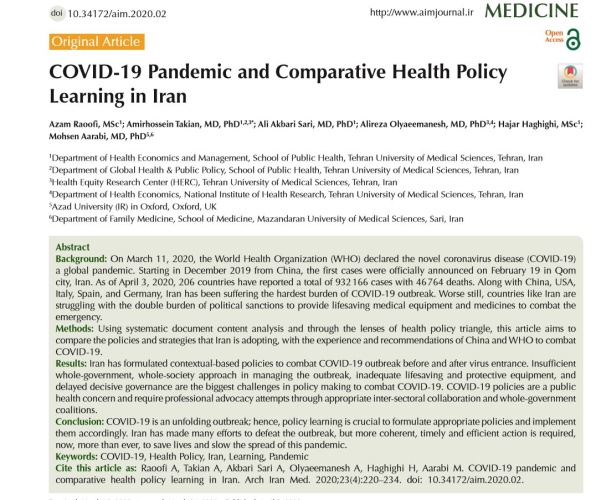COVID-19 Pandemic and Comparative Health Policy Learning in Iran
COVID-19 in Iran
World Health Organization Actions in Response to the Outbreak

COVID-19 Pandemic and Comparative Health Policy Learning in Iran
Azam Raoofi, MSc1; Amirhossein Takian, MD, PhD1,2,3*; Ali Akbari Sari, MD, PhD1; Alireza Olyaeemanesh, MD, PhD3,4; Hajar Haghighi, MSc1; Mohsen Aarabi, MD, PhD5,6
Introduction Coronaviruses are a common family in humans and animals that usually cause respiratory and intestinal infections. Until the outbreak of the severe acute respiratory syndrome (SARS) in 2003 in China, and then the Middle Eastern coronavirus (MERS-CoV), this group of viruses were not considered as dangerous and uncontrollable.1-3 In December 2019, a novel coronavirus emerged in Wuhan, China, and has since spread rapidly to almost all countries around the world, with an increasing number of patients and victims of the disease.4,5 On December 31, 2019, the Health Commission of Hubei province in China reported 27 people with pneumonia of unknown cause. On January 7, 2020, Chinese authorities announced the identification of a new type of coronavirus. On January 11, the number of infected people increased to 41 and the first death due to
the virus was reported. Chinese officials reported to the World Health Organization (WHO) that the disease was first seen among some people who sell seafood and live or fresh slaughtered animals.6 The first case outside of China was reported on 13 January in Thailand.5 With the death toll rising, on January 30, 2020, WHO declared a “Global Emergency” and on February 11 announced that the novel coronavirus would be called “COVID-19”. The coincidence of the outbreak with the onset of the Chinese New Year and the peak travel time contributed to the widespread worldwide outbreak. Cases with mild clinical symptoms, and lack of appropriate infrastructure to isolate infected individuals, especially in low- and middle-income countries, are barriers to controlling the disease.5 On March 11, 2020, WHO declared the coronavirus outbreak a “Global Pandemic”.7 Following the ongoing spread of the disease, on March 16, the number of worldwide infected people exceeded that of China (Figure 1).8 On February 19, Iran confirmed two cases of death due to COVID-19 in the city of Qom, 150 km south of the capital city of Tehran.9 This was the first report of death officially diagnosed as COVID-19 in West Asia, Middle East and North Africa.10 Despite identification of the disease within a few weeks, measures to contain the pandemic have been insufficient. As of April 3, there were 932 166 cases in 206 countries, of whom 46 764 died and 214 803 recovered.11 Figure 1 illustrates the chronological development of COVID-19 to date.
COVID-19 in Iran Following its worldwide spread and two deaths in Qom city, on February 19, the Iranian officials announced the COVID-19 outbreak in the country. The Iranian Ministry of Health and Medical Education (MoHME) does not count any suspicious death prior to the above date as related to COVID-19. The virus spread was rapid in Iran and by March 5, 2020, all 31 provinces were infected. The total number of confirmed cases by April 3 was 53 183, with 3294 deaths and 17 935 recoveries reported in Iran (Figure 2). The coincidence of the COVID-19 pandemic and its alarming outcomes in Iran with the highest unilateral sanctions imposed by the United States against Iran has posed many obstacles to the country’s health sector,12 which is one of the most efficient and resilient health systems in the Eastern Mediterranean region,13 to combat
against virus. This has led to scaling up the burden of the epidemic and the number of casualties.12
World Health Organization Actions in Response to the Outbreak Following the global emergency of COVID-19, WHO in collaboration with the United Nations (UN) SecretaryGeneral, has launched daily reports on the epidemical situation of the disease and COVID-19 Strategic Preparedness and Response Plan (SPRP) with the aim of providing a practical guide for member states to develop a Country Preparedness and Response Plan (CPRP) to the COVID-19 outbreak.14 Subsequently, on February 16−24, 2020, WHO formed a joint mission to provide rapid information at national (China) and international levels for future action in response to the ongoing outbreak of COVID-19 and the readiness of countries not yet infected with the virus. The results of the joint mission work in China were provided in the form of recommendations in five key areas that are presented in Table 1.15 In a joint statement with the World Tourism Organization (WTO), WHO also made recommendations to guide travel in response to COVID-19.16 Moreover, WHO has set up an Operations Supply and Logistics team consisting of various experts to advise and improve the management and coordination of information and to monitor and evaluate member states’ actions and to provide medical, laboratory and protective equipment to these countries.17 The group travelled to Iran on March 2, 2020 to work with Iranian health authorities to prepare for the battle against COVID-19 in Iran with a cargo of medical and personal protective equipment.
Arch Iran Med. 2020;23(4):220–234. doi: 10.34172/aim.2020.02.


Your Comment :